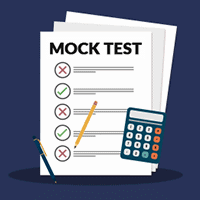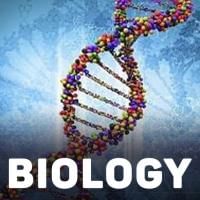NEET Exam > NEET Questions > Consider the following statement :(A) Coenzym...
Start Learning for Free
Consider the following statement :
(A) Coenzyme or metal ion that is tightly bound to enzyme protein is called prosthetic group.
(B) A complete catalytic active enzyme with its bound prosthetic group is called apoenzyme.
Select the CORRECT option.
(A) Coenzyme or metal ion that is tightly bound to enzyme protein is called prosthetic group.
(B) A complete catalytic active enzyme with its bound prosthetic group is called apoenzyme.
Select the CORRECT option.
- a)Both (A) and (B) are true.
- b)(A) is true but (B) is false.
- c)Both (A) and (B) are false.
- d)(A) is false but (B) is true.
Correct answer is option 'B'. Can you explain this answer?
Most Upvoted Answer
Consider the following statement :(A) Coenzyme or metal ion that is ti...
(A) is true because prosthetic group tightly bound to coenzyme or metal ion.
(B) is false because complete catalytic active enzyme with its bound prosthetic group is called Holoenzyme.
(B) is false because complete catalytic active enzyme with its bound prosthetic group is called Holoenzyme.
Free Test
FREE
| Start Free Test |
Community Answer
Consider the following statement :(A) Coenzyme or metal ion that is ti...
Statement (A): Coenzyme or metal ion that is tightly bound to enzyme protein is called prosthetic group.
Coenzymes and metal ions are essential cofactors required for the proper functioning of enzymes. Coenzymes are small, organic molecules that are loosely bound to the enzyme protein and are necessary for the enzyme's catalytic activity. In contrast, prosthetic groups are coenzymes or metal ions that are tightly bound to the enzyme protein. They are usually involved in the enzyme's active site and participate directly in the catalytic reaction. Therefore, statement (A) is correct.
Statement (B): A complete catalytic active enzyme with its bound prosthetic group is called apoenzyme.
Apoenzyme refers to an enzyme lacking its necessary cofactor or prosthetic group. In other words, it is the protein component of an enzyme without any bound cofactor or prosthetic group. The apoenzyme itself lacks catalytic activity and requires the presence of its cofactor or prosthetic group to become fully active. Therefore, statement (B) is incorrect as it defines an apoenzyme rather than an enzyme with its bound prosthetic group.
Conclusion:
Based on the explanations above, we can conclude that statement (A) is true, but statement (B) is false. Therefore, the correct option is (B): (A) is true, but (B) is false.
Coenzymes and metal ions are essential cofactors required for the proper functioning of enzymes. Coenzymes are small, organic molecules that are loosely bound to the enzyme protein and are necessary for the enzyme's catalytic activity. In contrast, prosthetic groups are coenzymes or metal ions that are tightly bound to the enzyme protein. They are usually involved in the enzyme's active site and participate directly in the catalytic reaction. Therefore, statement (A) is correct.
Statement (B): A complete catalytic active enzyme with its bound prosthetic group is called apoenzyme.
Apoenzyme refers to an enzyme lacking its necessary cofactor or prosthetic group. In other words, it is the protein component of an enzyme without any bound cofactor or prosthetic group. The apoenzyme itself lacks catalytic activity and requires the presence of its cofactor or prosthetic group to become fully active. Therefore, statement (B) is incorrect as it defines an apoenzyme rather than an enzyme with its bound prosthetic group.
Conclusion:
Based on the explanations above, we can conclude that statement (A) is true, but statement (B) is false. Therefore, the correct option is (B): (A) is true, but (B) is false.

|
Explore Courses for NEET exam
|

|
Similar NEET Doubts
Question Description
Consider the following statement :(A) Coenzyme or metal ion that is tightly bound to enzyme protein is called prosthetic group.(B) A complete catalytic active enzyme with its bound prosthetic group is called apoenzyme.Select the CORRECT option.a)Both (A) and (B) are true.b)(A) is true but (B) is false.c)Both (A) and (B) are false.d)(A) is false but (B) is true.Correct answer is option 'B'. Can you explain this answer? for NEET 2025 is part of NEET preparation. The Question and answers have been prepared according to the NEET exam syllabus. Information about Consider the following statement :(A) Coenzyme or metal ion that is tightly bound to enzyme protein is called prosthetic group.(B) A complete catalytic active enzyme with its bound prosthetic group is called apoenzyme.Select the CORRECT option.a)Both (A) and (B) are true.b)(A) is true but (B) is false.c)Both (A) and (B) are false.d)(A) is false but (B) is true.Correct answer is option 'B'. Can you explain this answer? covers all topics & solutions for NEET 2025 Exam. Find important definitions, questions, meanings, examples, exercises and tests below for Consider the following statement :(A) Coenzyme or metal ion that is tightly bound to enzyme protein is called prosthetic group.(B) A complete catalytic active enzyme with its bound prosthetic group is called apoenzyme.Select the CORRECT option.a)Both (A) and (B) are true.b)(A) is true but (B) is false.c)Both (A) and (B) are false.d)(A) is false but (B) is true.Correct answer is option 'B'. Can you explain this answer?.
Consider the following statement :(A) Coenzyme or metal ion that is tightly bound to enzyme protein is called prosthetic group.(B) A complete catalytic active enzyme with its bound prosthetic group is called apoenzyme.Select the CORRECT option.a)Both (A) and (B) are true.b)(A) is true but (B) is false.c)Both (A) and (B) are false.d)(A) is false but (B) is true.Correct answer is option 'B'. Can you explain this answer? for NEET 2025 is part of NEET preparation. The Question and answers have been prepared according to the NEET exam syllabus. Information about Consider the following statement :(A) Coenzyme or metal ion that is tightly bound to enzyme protein is called prosthetic group.(B) A complete catalytic active enzyme with its bound prosthetic group is called apoenzyme.Select the CORRECT option.a)Both (A) and (B) are true.b)(A) is true but (B) is false.c)Both (A) and (B) are false.d)(A) is false but (B) is true.Correct answer is option 'B'. Can you explain this answer? covers all topics & solutions for NEET 2025 Exam. Find important definitions, questions, meanings, examples, exercises and tests below for Consider the following statement :(A) Coenzyme or metal ion that is tightly bound to enzyme protein is called prosthetic group.(B) A complete catalytic active enzyme with its bound prosthetic group is called apoenzyme.Select the CORRECT option.a)Both (A) and (B) are true.b)(A) is true but (B) is false.c)Both (A) and (B) are false.d)(A) is false but (B) is true.Correct answer is option 'B'. Can you explain this answer?.
Solutions for Consider the following statement :(A) Coenzyme or metal ion that is tightly bound to enzyme protein is called prosthetic group.(B) A complete catalytic active enzyme with its bound prosthetic group is called apoenzyme.Select the CORRECT option.a)Both (A) and (B) are true.b)(A) is true but (B) is false.c)Both (A) and (B) are false.d)(A) is false but (B) is true.Correct answer is option 'B'. Can you explain this answer? in English & in Hindi are available as part of our courses for NEET.
Download more important topics, notes, lectures and mock test series for NEET Exam by signing up for free.
Here you can find the meaning of Consider the following statement :(A) Coenzyme or metal ion that is tightly bound to enzyme protein is called prosthetic group.(B) A complete catalytic active enzyme with its bound prosthetic group is called apoenzyme.Select the CORRECT option.a)Both (A) and (B) are true.b)(A) is true but (B) is false.c)Both (A) and (B) are false.d)(A) is false but (B) is true.Correct answer is option 'B'. Can you explain this answer? defined & explained in the simplest way possible. Besides giving the explanation of
Consider the following statement :(A) Coenzyme or metal ion that is tightly bound to enzyme protein is called prosthetic group.(B) A complete catalytic active enzyme with its bound prosthetic group is called apoenzyme.Select the CORRECT option.a)Both (A) and (B) are true.b)(A) is true but (B) is false.c)Both (A) and (B) are false.d)(A) is false but (B) is true.Correct answer is option 'B'. Can you explain this answer?, a detailed solution for Consider the following statement :(A) Coenzyme or metal ion that is tightly bound to enzyme protein is called prosthetic group.(B) A complete catalytic active enzyme with its bound prosthetic group is called apoenzyme.Select the CORRECT option.a)Both (A) and (B) are true.b)(A) is true but (B) is false.c)Both (A) and (B) are false.d)(A) is false but (B) is true.Correct answer is option 'B'. Can you explain this answer? has been provided alongside types of Consider the following statement :(A) Coenzyme or metal ion that is tightly bound to enzyme protein is called prosthetic group.(B) A complete catalytic active enzyme with its bound prosthetic group is called apoenzyme.Select the CORRECT option.a)Both (A) and (B) are true.b)(A) is true but (B) is false.c)Both (A) and (B) are false.d)(A) is false but (B) is true.Correct answer is option 'B'. Can you explain this answer? theory, EduRev gives you an
ample number of questions to practice Consider the following statement :(A) Coenzyme or metal ion that is tightly bound to enzyme protein is called prosthetic group.(B) A complete catalytic active enzyme with its bound prosthetic group is called apoenzyme.Select the CORRECT option.a)Both (A) and (B) are true.b)(A) is true but (B) is false.c)Both (A) and (B) are false.d)(A) is false but (B) is true.Correct answer is option 'B'. Can you explain this answer? tests, examples and also practice NEET tests.

|
Explore Courses for NEET exam
|

|
Signup to solve all Doubts
Signup to see your scores go up within 7 days! Learn & Practice with 1000+ FREE Notes, Videos & Tests.






















